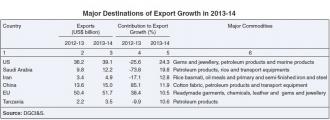
Indias CAD increases two-fold to $7.2 bn in Q2
The Dollar Business Bureau India’s current account deficit (CAD) in the second quarter of this fiscal increased two-fold to $7.2 billion or 1.2% of gross domestic product (GDP) on year-on-year basis, due to higher increase in merchandise imports, mainly oil, according to the Reserve Bank of India (RBI). However, it is narrowed steeply from $15 billion or 2.5% of GDP compared to the preceding quarter of 2017-18. “India’s CAD at $7.2 billion (1.2% of GDP) in Q2 of 2017-18 narrowed sharply from $15 billion (2.5% of GDP) in the preceding quarter, but was substantially higher than $3.4 billion (0.6% of GDP) in Q2 of 2016-17,” the RBI said on Wednesday. “The widening of the CAD on a year-on-year basis was primarily on account of ...

Gold imports surge 3-fold to $3.85 bn in April
The Dollar Business Bureau India’s gold imports surged to $3.85 billion during April 2017, witnessing a three-fold rise, mainly due to increased demand on Akshaya Tritiya. In April 2016, the country’s gold imports were $1.23 billion, according to official data released on Monday. Imports of the yellow metal were on a downward trend between February-September 2016. The imports rose in the months of October and November but declined in December and January. In February and March this year, the imports of the precious metal recorded a high rate of growth. In March 2017, imports of gold had surged to $4.17 billion compared to $974 million in the same month in 2016. The rise in gold imports had led to a widening of trade deficit in April 2017 to $13.2 billion ...

Indias gold imports up 23% in November
The Dollar Business Bureau India’s gold imports grew 23.24% to $4.36 billion in November compared to $3.54 billion in November last year. According to the official data, imports of yellow metal grew for the second consecutive month in November by 23.24% to $4.36 billion due to a decrease in prices. The industry is also guessing other reasons for the decline in the import of the precious metal; among others were Prime Minister Narendra Modi’s decision to demonitise Rs.500 and Rs.1000 rupee notes and the ongoing wedding season. There were reports after the November 8 announcements that there was a sudden spike in gold demand in the domestic market, as consumers were using their old currency to buy gold. The imports of gold have been on a ...

Sensex, Nifty ride high on firm global cues
The Dollar Business Bureau BSE Sensex and NSE Nifty ended the day on high on Friday, riding on an increased buying in frontline blue chip counters and positive global clues. Sensex settled 100.45 points up at 26,625.91, while Nifty index ended 29.45 points up at 8,170.20. Companies such as Bharti Airtel, HDFC, Power Grid, Tata Motors and Tata Motors DVR gained in the range of 1.64% - 3.27%. However, Bharti Infratel, Dr Reddy’s Labs, Sun Pharma, Tata Power and Tata Steel fell between 1.57% and 3.55%. On Thursday, the Sensex crashed more than 400 points, due to looming uncertainty over Brexit and the reduced economic growth forecast of the US by the Federal Reserve. However, investors continue to refrain from undertaking any financial activities amidst ...

Indias CAD drops to $0.3 bn in Q4
The Dollar Business Bureau Due to low trade gap, India’s Current Account Deficit declined to $0.3 billion in fourth quarter of FY16 from $7.1 billion registered in third quarter of the same fiscal. CAD is the difference between the outflow and the inflow of foreign exchange. The GDP for the fourth quarter accounted for 0.1% as against 1.3% recorded in third quarter. For the financial year 2016, CAD shrunk by 1.1% of the GDP. The Reserve Bank of India, on Friday, stated that the decline to $0.3 billion, with GDP at 0.1%, was marginally lower than $0.7 billion, or 0.1% GDP, recorded in FY15. The reduction of CAD in Q4 of FY16 was mainly due to low trade defcit, which accounted for $24.8 billion ...

Gold imports shrink nearly 8% in 2015-16
The Dollar Business Bureau India’s gold imports fell about 8% in the financial year 2015-16, thereby bringing down the country’s current account defect to a record low. The imports of gold stood at $31.72 billion in 2015-16 as against $34.38 billion in 2014-15. The imports of yellow-metal sank 80.48% to $972.96 million in March this year when compared to $4.98 billion last March. The lesser imports was largely due to the long strike undertaken by the jewellers. They were protesting against the union government’s proposed 1% excise duty on imports of non-silver jewellery. Similarly the contracting gold prices in both international and national markets were also the paramount reason for its less imports. In March, gold was the single largest contributor to the country’s ...

Lower commodity prices will help reduce Indias import bill
Bidhu Bhushan Palo | @TheDollarBiz While earnings from agriculture exports are expected to decline slightly due to the prevailing low prices of commodities, India’s overall import bill is expected to decline significantly due to lower prices of oil and gold in 2014-15, which will help reduce the country’s trade deficit. Earlier this month, the World Bank projected that prices of most primary commodities have declined since last year and are expected to remain weak in the remaining months of 2014 and through much of 2015. The trend is partly due to a slowdown in the Euro Area and emerging economies, a strong US dollar, increased oil supplies, and good crop prospects. There are several positives in the changes for ...

External sector doing remarkably well, says Reserve Bank of India
The Dollar Business Bureau | @TheDollarBiz The Reserve Bank of India (RBI) says that policy efforts, improvement in exports and a steep decline in imports helped reduce the full year current account deficit (CAD) in FY2013-14 to $32.4 billion or 1.7% of GDP (valued at around $1.9 trillion) from the large deficit of 4.9% of GDP recorded in Q1 of FY2013-14. “Following a lower trade deficit accompanied by robust growth in services export and stable flows of remittances, CAD declined to 1.7% of GDP in 2013-14,” the RBI says in its Annual Report (ended June 30, 2014). Policy decisions to curb gold imports last year were effective, and other factors such as low international prices of oil, fertilisers and ...


